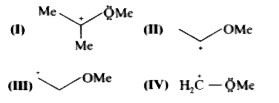The following structures are resonance contributors for a reactive intermediate formed during ozonolysis of alkenes. Identify the most energetically favorable and the least favorable contributors.

III is most favorable and II is least favorable
I is most favorable and IV is least favorable
II is most favorable and IV is least favorable
I is most favorable and II is least favorable
The correct Answer is:B
In Ist all atoms have complete octet.
In IVth structure O-atom incomplete octet and carries positive charge.
Topper's Solved these Questions
- HYDROCARBON (ALIPHATIC)BOOK - GRB PUBLICATIONCHAPTER - HYDROCARBON (ALIPHATIC)EXERCISE - Reasoning Type
15 Videos
- HYDROCARBON (ALIPHATIC)BOOK - GRB PUBLICATIONCHAPTER - HYDROCARBON (ALIPHATIC)EXERCISE - Multiple Objective Type
56 Videos
- GRAPHICAL INTERPRETATIONBOOK - GRB PUBLICATIONCHAPTER - GRAPHICAL INTERPRETATIONEXERCISE - Subjective Type
23 Videos
- HYDROGEN AND ITS COMPOUNDSBOOK - GRB PUBLICATIONCHAPTER - HYDROGEN AND ITS COMPOUNDSEXERCISE - Subjective type
8 Videos
Similar Questions
Identify the most reactive and the least reactive metal amongst the following: AI, K, Cu, Au.
View SolutionFor the following bond cleavages, use curved arrows to show the electron flow and classify each as homolysis or heterolysis. Identify reactive intermediate produced during the fission.

View Solution
Knowledge Check
Which of the following represents a resonance form of the intermediate formed during bromination fo amiline?
A B
B C
C D
D
Which of the following pairs of Lewis structure represent resonance contributor to the species?
A B
B C
C D
D
In the following sets of resonating structure, lable the major contributors towards resonance hybrid.
 AII, II, I, IIBII, II, II, ICII, II, II, IIDI, I, II, I
AII, II, I, IIBII, II, II, ICII, II, II, IIDI, I, II, I
The theory of resonance was developed primarily by Pauling in the 1930s. According to this theory , many molecules and ions are best described by writing two or more Lewis structure and considering the real molecule of ion to be a composite of these structures .They are also sometimes referred to as resonance structures or resonance contributors . We show that the real molecule or ion is a resonance hybrid of the various contributing structures by interconnecting them with double headed arrows . Resonance structures are not in equilibrium with each other .
 .
.
Find out the stability order of intermediate .

View SolutionThe theory of resonance was developed primarily by Pauling in the 1930s. According to this theory , many molecules and ions are best described by writing two or more Lewis structure and considering the real molecule of ion to be a composite of these structures .They are also sometimes referred to as resonance structures or resonance contributors . We show that the real molecule or ion is a resonance hybrid of the various contributing structures by interconnecting them with double headed arrows . Resonance structures are not in equilibrium with each other .
 .
.
Stability order of the following resonatin structure will be

View SolutionAmong the following four structures, one is not a permissible resonance form. Identify the wrong structure.
View SolutionThe order of reactivity of the following compounds in electrophilic monochlorinatic the most favorable position is

View SolutionWhich among the following alkenes will be most reactive during hydrogenation reaction
View Solution
